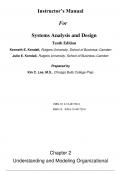Exam (elaborations)
Instructor’s Manual For Systems Analysis and Design Tenth Edition by Kenneth E. Kendall, Julie E. Kendall
Instructor’s Manual For Systems Analysis and Design Tenth Edition by Kenneth E. Kendall, Julie E. Kendall. I. Systems Analysis Fundamentals Systems, Roles, and Development Methodologies Understanding and Modeling Organization Systems Project Management II. Information Requirements Analysis Inform...
[Show more]



